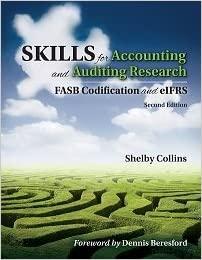Question
Alternative Investment Bases Chapter 7 in the textbook discusses how differences in the amounts used to calculate ROI can impact performance evaluation. I found the
Alternative Investment Bases
Chapter 7 in the textbook discusses how differences in the amounts used to calculate ROI can impact performance evaluation. I found the reading very tedious and difficult to understand. This problem provides a simple example of how alternative investments bases affect the calculation of ROI (and therefore, affect performance evaluation).
Basic Information:
The T Division of A.T. Enterprises has depreciable assets costing $2 million. The cash flows from these assets for 3 years follow:
Year Cash Flow
$600,000
$700,000
$600,000
Depreciation of these assets is 10% per year; the assets have no salvage value.
Assumptions:
A.T. calculates Return on Investment as follows:
ROI = NOI / Investment
Required:
Compute ROI for each year by recreating the tables on the following pages assuming that investment is calculated using:
Net book value
Gross book value
Visually compare each method separately across the three years (i.e., dont compare Net Book Value to Gross Book Value). Based on your visual comparison, which method is better for evaluating performance? Why?
Alternative Investment Bases
NET BOOK VALUE
For Net Book Value:
NOI = Cash Flows Depreciation Expense
Investment Base = Depreciable Assets Accumulated Depreciation at year end
Year 1 has been completed as an example.
|
|
Year 1 |
Year 2 |
Year 3 |
|
NOI (a) |
$600,000 ($2,000,000 x 10%) $400,000
|
|
|
|
Investment Base (b) |
$2,000,000 x 90%* $1,800,000
|
|
|
|
ROI (a)/(b) |
$400,000 = 22.22% $1,800,000
|
|
|
* Alternatively, $2,000,000 ($2,000,000 x 10%)
Alternative Investment Bases
GROSS BOOK VALUE o For Net Book Value:
o NOI = Cash Flows Depreciation Expense o Investment Base = Depreciable Assets
Year 1 has been completed as an example.
|
|
Year 1 |
Year 2 |
Year 3 |
|
NOI (a) |
$600,000 ($2,000,000 x 10%) $400,000
|
|
|
|
Investment Base (b) |
$2,000,000
|
|
|
|
ROI (a)/(b) |
$400,000 = 20% $2,000,000
|
|
|
Note that this example only manipulates one variable Investment Base Net Book Value vs. Gross Book Value. Other Investment Base variations include: (1) Beginning of the Year vs. End of the Year vs. Average Book Balance and (2) Historical Cost vs. Current Cost. It can be quite complicated to ensure that the performance evaluation method being used is encouraging goal congruent behavior.
Step by Step Solution
There are 3 Steps involved in it
Step: 1

Get Instant Access to Expert-Tailored Solutions
See step-by-step solutions with expert insights and AI powered tools for academic success
Step: 2

Step: 3

Ace Your Homework with AI
Get the answers you need in no time with our AI-driven, step-by-step assistance
Get Started


